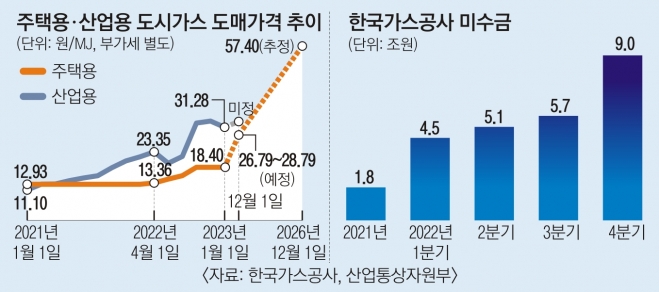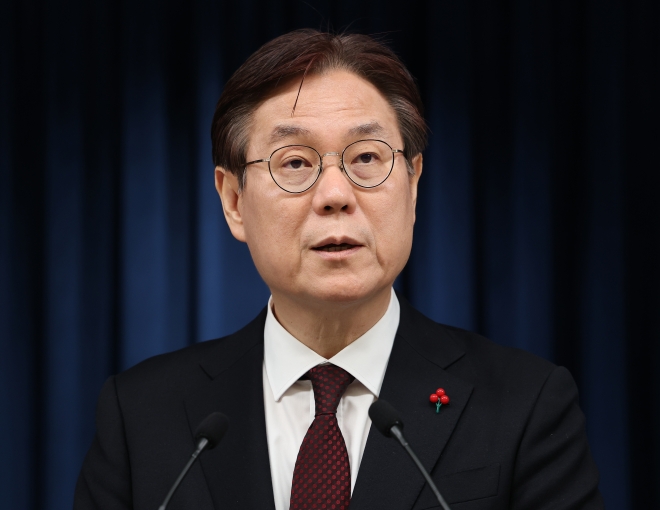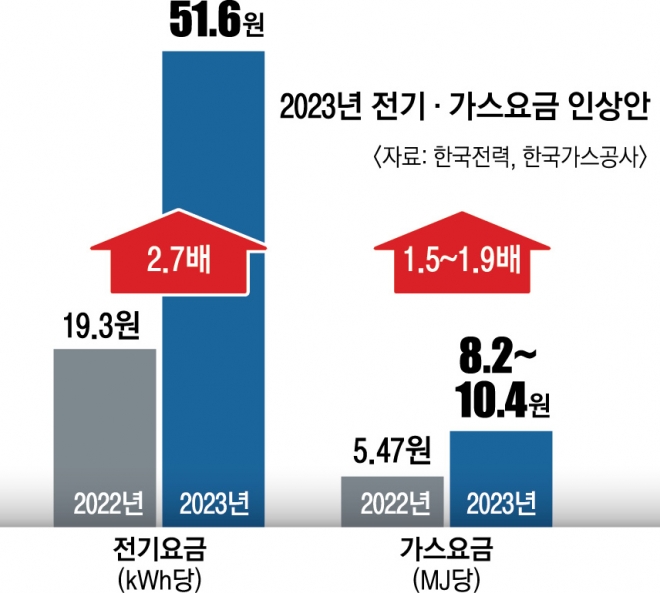KOGAS Reports Rate Increase Factors to the National Assembly
39 won per MJ needs to be raised… 7 times last year’s increase
Accounts receivable from Gas Corporation, 9 trillion, up by 7 trillion in one year
International natural gas, 10-fold increase in a year and a half
As the year-end approaches, the burden of heating costs will increase
Reduced industrial gas prices? 3 times increase in 2 years
▲ An elderly man descending the ice stairs
On the 26th, the stairs in Dongja-dong, Yongsan-gu, Seoul are frozen.
The government has decided to expand energy voucher support and gas rate discounts to relieve the burden of the vulnerable due to ‘heating cost bomb’. 2023. 1. 26 Yonhap News
▲ Amid the realization of a ‘heating cost bomb’ due to soaring global energy prices, KOGAS is planning to recover 9 trillion won in receivables for raw material costs for civil city gas, such as for housing, within this year. It was confirmed on the 29th that it reported to the National Assembly that the won should be raised.
In the midst of global energy supply and demand turmoil, the shock of the ‘heating cost bomb’ bill due to the sharp rise in liquefied natural gas (LNG) import prices is gone. It was found that the rate should be raised by 39 won per megajoule (MJ), which is three times the current rate. This is about 7 times the increase in residential gas rates last year (5.47 won), and KOGAS plans to push for a step-by-step increase by 2026 in consideration of the price burden. expected to deepen.
In case of phased increase in 2026
1.5 to 1.8 times increase in gas prices from April
According to the rate increase factor data submitted by KOGAS to the National Assembly on the 29th, KOGAS reported to the National Assembly that it needs to raise the gas fee by 39 won per MJ from the second quarter in order to recover all of the receivables of KOGAS until the end of last year within this year. Considering that the retail gas rate for housing in Seoul is 19.69 won per MJ as of the 1st of this month, it is taken as meaning that the rate should be raised to 58.69 won, which is three times the current rate.
As KOGAS freezes gas rates in the first quarter of this year, receivables can increase by more than 5 trillion won, and since it is still supplying gas at a lower price than the cost of natural gas, it is emphasizing that a rate hike is inevitable to prevent additional receivables from accumulating. . However, considering the price shock that the common people will receive when raising gas prices all at once, the plan is to set up a plan for a gradual increase until 2026, before the next administration takes office, through consultation with the government.
KOGAS believes that receivables can be resolved in 2027 if this year’s rate is raised by 8.4 won per MJ, and in 2026 if it is raised by 10.4 won. This means that the rate is at least 1.5 to 1.8 times higher than the current rate.
Accounts receivable from KOGAS has increased sharply since February of last year, when Russia waged a war against Ukraine. Accounts receivable, which was only 200 billion won at the end of 2020, began to increase in the second half of 2021, when the war began in earnest, with a sharp rise in natural gas prices, reaching 1.8 trillion won at the end of 2021, and soared when Russia stopped supplying LNG in February last year. It jumped to 9 trillion won, an increase of 7 trillion won in one year.
Natural gas prices rose more than tenfold from $6.1 per MMBtu in March 2021 to $69.3 in September last year, when the price peaked, and stabilized somewhat at $35.6 last month as the weather in Europe became milder due to the winter weather in December.
Industrial, KRW 11.1 → KRW 31.3 181.8%↑
For housing, KRW 12.93 → KRW 18.40 42%↑
Some point out that only residential gas prices went up and industrial ones went down slightly this month, but according to Gas Corporation’s natural gas rate information, the wholesale price of industrial city gas, which is subject to the fuel cost indexation system, is 11.10 won per MJ in January 2021, and international natural gas prices are expected to rise. After starting at 12.96 won in March 2021, it went up and down steadily, rising 156.6% in two years to 20.45 won in December of that year and 33.26 won in December last year.
Currently, the international natural gas price is slightly lower, and the industrial gas wholesale rate is 31.28 won, but it is higher than the residential wholesale rate (18.40 won), which has risen by 38.5% (5.47 won) over four times last year (April, May, July, and October). to be. From January 2021 to the present, industrial city gas wholesale rates rose 181.8%.
On the other hand, city gas wholesale rates for residential use rose 42.2% over the past two years from January 2021 to the present. The Ministry of Trade, Industry and Energy said that residential gas rates that did not apply the fuel cost linkage system did not rise even once while being frozen for seven rate adjustment periods from 12.93 won per MJ in March 2021, the previous government, to April last year.
▲ The self-employed industry is burdened by the increase in gas rates
On the 27th, when the burden on self-employed people is growing due to the reduction in public utility bills such as electricity and gas, a restaurant in Seoul is making food using city gas. According to the National Statistical Office’s consumer price survey, city gas prices in December last year rose 36.2% and district heating costs 34.0% from a year ago. 2023.1.27 Yonhap News
▲ Lee Kwan-seop, chief of state affairs planning at the Presidential Office, is announcing the current status of subsidies and future plans for non-profit private organizations at the Presidential Office Building in Yongsan, Seoul on the 28th. 2022.12.28 Yonhap News
Chief of State Affairs and Planning “Energy price increase
It’s a failure that I couldn’t reflect it in time and postponed it.”
Lee Kwan-seop, chief of state affairs planning at the President’s Office, appeared on KBS’ Sunday Diagnosis Live broadcast that day and said, “Price is a signal of economic activity, so people can move accordingly. Failure to give the price signal in time is a failureHe pointed out that the Moon Jae-in administration delayed raising energy prices as a problem.
Senior Vice Minister Lee, who served as president of Korea Hydro & Nuclear Power under the Moon Jae-in administration, said, “I feel very sorry for the ‘heating cost bomb’.” It was cold, so the gas usage doubled.”
Chief Lee said, “As international prices rise, domestic prices must also adjust a little. Only then can households and businesses prepare, and the government can devise various support measures, but these things have not been reflected in time and have been delayed.”
Correspondent Sejong Kang Ju-ri






